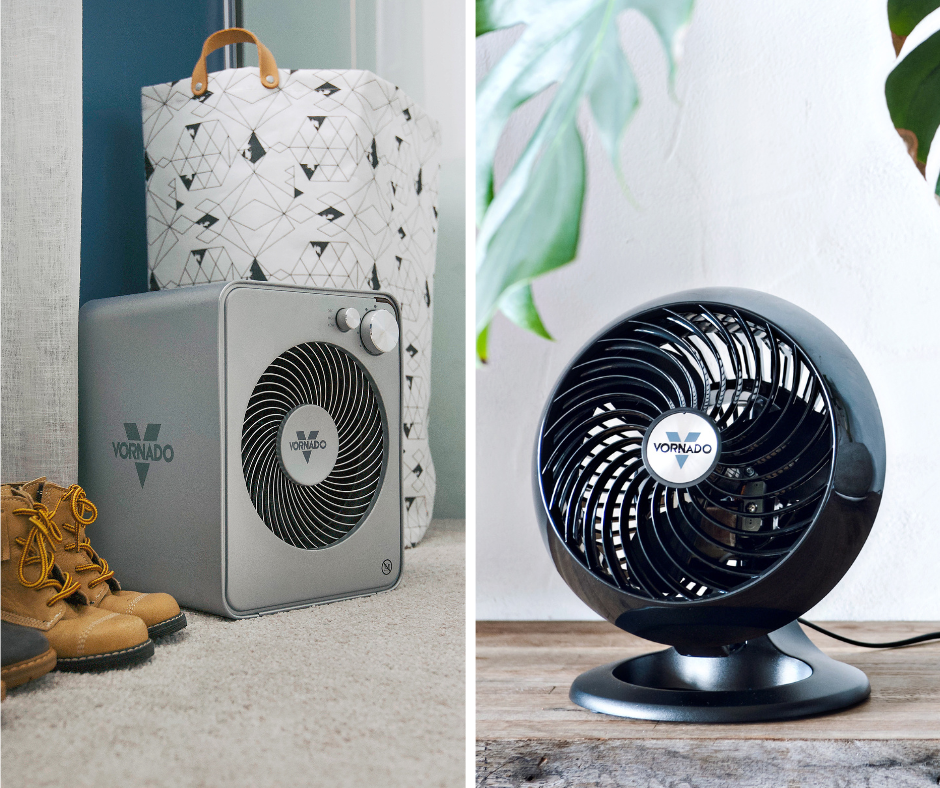
Vornado Fan Heater VS Vornado Air Circulator
Vornado AustraliaSame technology. Different intensity.
With both Vornado Fan Heaters and Vornado Air Circulators using Vortex Action technology to generate airflow in your space, it can be easy to assume that a Vornado Heater is just a Vornado Air Circulator with a heater built into it, right?
Well, if we were to simply put a heating element into a Vornado Air Circulator, dry skin would be the least of your worries… here’s why.
What's the difference between a Vornado Air Circulator and Vornado Fan Heater?
Let's Get Technical
The Vornado Heaters offer a consistent, gentle heat powered by our signature Vortex Action so no spot in the room is left cold. Operating at 1500W on high ($0.45 per hour), the Vornado Heaters are designed to heat the room you are in, rather than your whole house which lends to energy (and money) wastage.
The Vornado Air Circulators offer powerful air circulation as a standalone cooling unit and year-round use to make your split systems that bit more powerful. Rather than increasing the fan speed of your 3500W split system ($1.05 per hour), place your Air Circulator in front of the wall mounted system so it draws the cold/hot air through the back and propels it forward, using less than 54W ($0.03 per hour).
Air Circulators can be used as a standalone unit to move air throughout the room. Understanding that stagnant air is warmer than flowing air, and poorer for your health, we also recommend their use year round. In the height of Summer or depth of Winter, the Air Circulators can be used in conjunction with your reverse cycle or split system units. The Air Circulator draws the cold/hot air through the back of the unit and pushes it up to 30.5m into adjacent rooms. Using Vornado’s signature Vortex Action, the cold/hot air spirals throughout the room ensuring a consistent and comfortable temperature.
Similarly, the Vornado Whole Room Heaters utilise Vortex Action to gently disperse warm air throughout a room of up to 20sqm. They are a standalone unit, compact and convenient so you only need to heat the room you are in. With rising electricity costs, we are all feeling the pinch so the Vornado Whole Room Heaters are designed with cost efficiencies and a lack of energy wastage in mind.
With a cool-touch, powder-coated metal case, easy to use controls and discreet cord storage, this heater will not only elevate the look and feel of the typical home heater, but it'll also do its job remarkably well.
The VMH300 features a temperature dial with in-built thermostat so you can control the heat output of the unit with ease. The VMH350 features an easy-to-use remote control so you can focus in on a set temperature with complete accuracy.
Both units feature a metal inlet grill that keeps dust (and fingers) at bay, plus other safety features like tip-over protection to ensure peace of mind, along with a 5-year replacement warranty for purchase protection.
Key Differences between A Vornado Air Circulator and Vornado Heater
Now onto the differences, the main feature to note is the difference of speed of the blades between a Vornado Air Circulator and Vornado Heater. The Vornado Air Circulators work like a jet engine in reverse. Drawing large volumes of air in through the back of the unit, the air is then pushed through a cone inlet, across the deep pitch blades and propelled forward through the front grill. In the case of the 660, they move air up to 30.5m, bouncing the circulated air throughout the room.
This by comparison to the Vornado Heaters that work by setting the temperature of the heating element (via the control dial or remote control), selecting low or high (750W or 1500W) and gently pushing the heated air over the blades to circulate warm air in a room up to 20sqm. Set a desired temperature via the control panel (VMH350). The unit will then circulate heat to reach the desired temperature setting. Once the room temperature reaches the desired temperature, the unit will no longer circulate heat. Even though the product isn’t circulating heat, the unit still has power while the thermostat is reading the temperature in the room.
If the temperature in the room drops below the desired set temperature, the unit will activate the heat element and motor and start producing and circulating heat within the room. This cycle will continue to repeat itself as the product maintains the desired set temperature.
Regarding the mechanical control dial (VMH300), you will turn the temperature control knob up which will initiate the heater to start circulating heat. Once the room is warm enough per your comfort, you will dial the control knob back until the unit clicks off. Now if the temperature in the room drops below this desired set temperature, the unit will click back on and continue to generate heat until it reaches the set temperature again. It will continue this cycle as long as the heater is plugged in and positioned in the on position.
One suggestion we often receive is to increase the speed of the blades for the heaters, so they generate more heat. If we were to increase the speed of the fan blade, we would be pushing more air over the heating element which in turn would be cooling the element down and preventing the heater from heating the room. In theory it sounds like a great idea, but in practice it would work the opposite to your desired intent.
Invest In Comfort, Invest in Vornado
So sit back, relax and enjoy the efficiencies of the Vornado Air Circulators and Heaters and keep your home healthy and happy this year.
